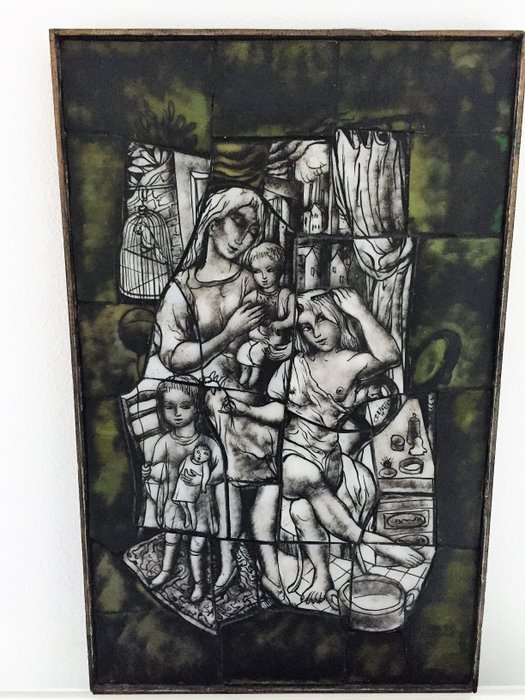编号 13183729

Stained glass painting - domestic scene - design: Max Weiss Plauen 1910 - Roermond 1972
编号 13183729

Stained glass painting - domestic scene - design: Max Weiss Plauen 1910 - Roermond 1972
width 31.5 cm and height 48.5 cm. Set in wooden frame.
Max Weiss
Plauen 1910 - Roermond 1972
referring to documentation
Text taken from "Glas in lood in Nederland 1817-1968", Dr. Carine Hoogveld
After obtaining the Glaziers diploma at the Academy in Munich, Weiss started working at the Bayerische Hofkunst Anstalt. In 1929, he came into contact with Joep Nicolas who was invited to work at this Hofkunst Anstalt. However, after a short orientation Nicolas declined and invited Weiss to work in the workshop Nicolas in Roermond.
When the chef d'atelier of the old family company Nicolas and Sons, G. Mesterom, established his own studio, he was succeeded by Weiss.
When Nicolas emigrated to America in 1939, he sold the studio to Max Weiss. At the time it was rumoured that Gisele Waterschoot van der Gracht would be Co-Director but this never came to fruition. Nicolas had, before his move to America, given Weiss licence to include the creation of opaline tableaux, for which he had obtained the patent in 1936. In addition to Max Weiss, Gisele Waterschoot van der Gracht was given permission to apply this technique independently.
Weiss was closely involved in all facets of the design and manufacture of the windows. In his studio the work of Charles Eyck was also created as was, until 1940, the work of Gisele Waterschoot van der Gracht.
The top years of the studio in terms of quantity, were between 1945 and 1957. In 1956 he had to take things easy and after 1969 his health no longer allowed him to accept commissions whereupon the studio was closed.
After Nicolas had moved to America, Weiss also designed himself. His windows clearly reflect that the work of Nicolas had a profound influence on his style. Weiss tried to match the fluid compositions and powerful lines and made use of the same bright, bold range of colours. He also often used grisaille, especially in the first few years to make his work less translucent.
Weiss was opposed to the pictorial ideas of Nicolas who believed the window should as little as possible be linked to architecture but rather be considered an independent 'painting'.
Weiss however, was of the opinion that in a dark church the windows had to fit in with the surroundings and thereby he positioned himself in a more 'northern' monumental approach. By using grisaille the window would not 'stand out', but blend in with the walls.
In the 1940s, Weiss' work was very picturesque. These windows are typical examples of the 'Baroque Limburg' from the 1920s and 1930s; yolks, romantic, playful, with remarkable scenic elements, wide perspectives and countryside motives, dynamic and agile with an illustrative narrative character. The compositions are often extremely full.
After the Second World War, Weiss briefly worked in Neo-Romanesque style, common in Brabant and Limburg at the time. The perspective disappeared to make way for smooth, decorative backgrounds. The figuration which before had provided the dashing accents in the volatile pattern of the composition, now filled the window panes to the edges and decreased from movement to static force. His work became more monumental.
